
Euphorbia is a very large and diverse genus of flowering plants, commonly called spurge, in the family Euphorbiaceae.
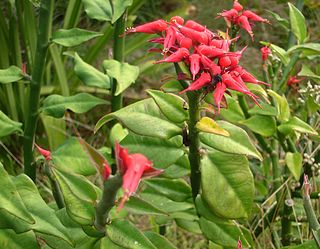
Euphorbia tithymaloides is a perennial succulent spurge. An erect shrub, the plant is also known by the scientific name Pedilanthus tithymaloides. However, the genus Pedilanthus has been subsumed into the genus Euphorbia, and is more correctly known by its new name.

Euphorbia lathyris, the caper spurge or paper spurge, is a species of spurge native to southern Europe, northwest Africa, and eastward through southwest Asia to western China.
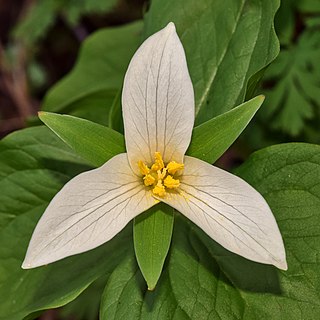
Trillium ovatum, the Pacific trillium, also known as the western wakerobin, western white trillium, or western trillium, is a species of flowering plant in the family Melanthiaceae. It is the most widespread and abundant trillium in western North America. Its type specimen was gathered by Meriwether Lewis during the return trip of the Lewis and Clark Expedition in 1806.

Euphorbia corollata is an herbaceous perennial plant in the family Euphorbiaceae that is native to North America. A common name for the species is flowering spurge. It has a milky sap that can cause skin and eye irritation in some people. It grows up to 1 m (3 ft) tall, with smooth stems and light green leaves arranged alternately or in whorls. Leaves are about 10 mm wide and 75 mm (3 in) long. Each stem terminates in a panicle 20 to 25 mm across. Flowers are about 6 mm across and consist of one pistillate and several staminate flowers surrounded by five white bracts - not petals but formed from the involucre at the base of the flowers. Flowering spurge blooms from June to September.

Euphorbia misera is a semi-succulent shrub in the genus Euphorbia commonly known as the cliff spurge or coast spurge. A drought-deciduous shrub, it is typically found as a gnarled, straggly plant occupying seashore bluffs, hills and deserts. Like other members of its genus, it has a milky sap, which can be found exuding out of the light gray bark when damaged. The alternately-arranged leaves are round and folded in the middle, with small hairs on them. The "flowers" can be found blooming year-round, and are colored maroon or yellow in the center with 5 white to light-yellow petal-like appendages attached outside. This species is native to the Baja California peninsula and Sonora in Mexico, and the coast of southern California in the United States, where it is a rare species. It is threatened in some localities by the development of its coastal habitat, which tends to be prime locations for high-end residential and commercial developments.

Euphorbia serrata is a species of spurge known by the common names serrated spurge and sawtooth spurge, and also known as Tintern spurge and upright spurge. It is native to Europe but it is present elsewhere as a weedy introduced species. This is a perennial herb growing anywhere from 20 centimetres to about half a metre in height. The leaves are long and very narrow on most of the plant, with more oval-shaped leaves toward the tips of the stems. They are finely toothed. At the ends of the branches are inflorescences of tiny flowers. The fruit is a spherical capsule about half a centimetre wide containing tiny gray seeds.

Euphorbiaceae, the spurge family, is a large family of flowering plants. In English, they are also commonly called euphorbias, which is also the name of the type genus of the family. Most spurges, such as Euphorbia paralias, are herbs, but some, especially in the tropics, are shrubs or trees, such as Hevea brasiliensis. Some, such as Euphorbia canariensis, are succulent and resemble cacti because of convergent evolution. This family has a cosmopolitan global distribution. The greatest diversity of species is in the tropics; however, the Euphorbiaceae also have many species in nontropical areas of all continents except Antarctica.

Balsamorhiza sagittata is a North American species of flowering plant in the tribe Heliantheae of the family Asteraceae known by the common name arrowleaf balsamroot. Also sometimes called Oregon sunflower, it is widespread across western Canada and much of the western United States.

Euphorbia prostrata is a species of spurge known by the common name prostrate spurge or prostrate sandmat.

Euphorbia revoluta is a species of euphorb known by the common name threadstem sandmat. It is native to Mexico and the southwestern United States from California to the Rocky Mountains. It is an annual herb producing thin, erect stems with pairs of linear leaves, each leaf up to 2.6 centimeters long. The inflorescence is a cyathium with rounded nectar glands surrounding one female flower and several male flowers. There are sometimes white petal-like appendages as well. The Navajo used this plant as a skin lotion.
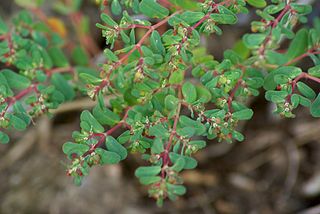
Euphorbia serpyllifolia is a species of euphorb known by the common names thymeleaf sandmat or thyme-leafed spurge. It is native to a large part of North America from Canada to Mexico, where it is a common member of the flora in many types of habitat. This is an annual herb growing as a prostrate mat or taking a somewhat erect form. The oblong leaves are up to about 1.5 centimeters long, sometimes hairy and finely toothed along the edges. The tiny inflorescence is a cyathium about a millimeter wide. It bears scalloped white petal-like appendages arranged around the actual flowers. At the center are several male flowers and one female flower, which develops into a lobed, oval fruit up to 2 millimeters wide. This plant had a number of traditional medicinal uses for many Native American groups.

Vernicia montana, the mu oil tree, or chine wood oil tree, is a species of Vernicia in the spurge family, native to Southeast Asia and southern China. It is a medium-sized deciduous tree reaching a height 20 metres (66 ft). The Latin specific epithet montana refers to mountains or coming from mountains. The leaves are large with three lobes. The monoecious white-petaled flowers emerged as inflorescences, containing both male and female flowers. The 2–3 inches (5.1–7.6 cm) fruit is a globular drupe with wrinkled skin that turns from green to yellow upon ripening. Each fruit contains 3 seeds, rich in oil.

Artemisia cana is a species of sagebrush native to western and central North America; it is a member of the sunflower family. It is known by many common names, including silver sagebrush, sticky sagebrush, silver wormwood, hoary sagebrush, and dwarf sagebrush.
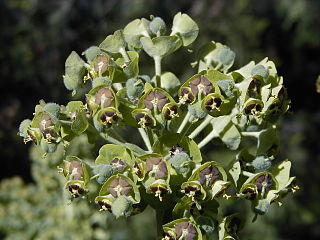
Euphorbia characias, the Mediterranean spurge or Albanian spurge, is a species of flowering plant in the family Euphorbiaceae typical of the Mediterranean vegetation. It is an upright, compact evergreen shrub growing to 1.2 m tall and wide.
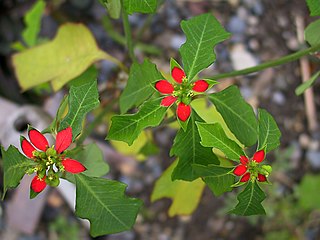
Euphorbia cyathophora, known by various names including painted spurge, dwarf poinsettia, fire-on-the-mountain, paintedleaf, and wild poinsettia. Native to subtropical and tropical North and South America, it is widely naturalized elsewhere. They belong to the Cyathium type of inflorescence. Here, the inflorescence axis is convex in shape. Dwarf poinsettia is an annual herb growing up to 3 feet tall. It has green stems with leaves that are oblanceolate with lobed margins. It grows near disturbed sites.

Euphorbia cotinifolia is a broadleaf red shrub native to Mexico and South America. Treated as a shrub, it reaches 10 to 15 ft but can be grown as a tree reaching 30 ft (9.1 m). Small white flowers with creamy bracts bloom at the ends of the branches in summer. The purplish stems, when broken, exude a sap that is a skin irritant.

Euphorbia pubentissima, commonly called the southeastern flowering spurge or false flowering spurge, is a species of plant in the spurge family. It is native to the Southeastern United States where it is found in areas of sandy, open woodlands. It produces small flowers surrounded by white involucral gland appendages from spring to fall.

Euphorbia mercurialina, commonly called mercury spurge, is a species of plant in the spurge family.

Euphorbia davidii, known as David's spurge or toothed spurge, is a species of flowering plant in the spurge family Euphorbiaceae. It is an annual herb growing up to 2 feet tall. Leaves are opposite in arrangement with narrow to broadly elliptic blades.





















